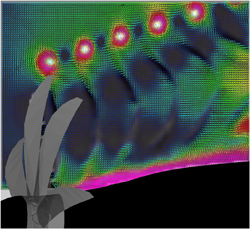Working together on particle paths
Particle image velocimetry (PIV) is one of the cornerstones in state-of-the-art avionics research. As the name suggests, it measures the velocity over time of small tracer particles introduced into a flow field. Software then translates the data into an image where the flow can be analysed. In the field of aerodynamics, PIV has been applied to a wide range of flow problems including the air flow over an aircraft wing in a wind tunnel. In this context it is responsible for improving the design of aeroplanes by modifying the structure of industrial wind tunnels. The EU-funded project PIVNET2 aimed to extend the scope of PIV technology by promoting information exchange between research laboratories and encouraging synergy between the network partners. The objective was to solve more complex, highly important research problems including icing and decay of wake vortex structures behind aircraft. Trailing vortices, for example, are a by-product of differing airflows on the upper and lower surfaces of aircraft wings that can persist for many kilometres. These can be very hazardous for smaller aircraft following larger ones. Research areas that still present many technological challenges include two-phase flows involving particles of different size, background illumination in flames and reflections from walls. All these involve complex research that cannot be handled by all laboratories. Due to financial and time constraints, it is crucial that researchers can compare their work with other labs to avoid duplication and provide that edge to their investigations. Project researchers have published a book of papers giving details of PIV techniques in a variety of application areas on the basis of PIVNET2 workshops. A set of interviews on particular applications has also been produced by the more expert scientists. Advancements in PIV research are not only applicable to aeronautics but to the car industry, turbomachinery, combustion and even for analysis of vortices in prosthetic heart valves. Many fields in European technological research could therefore benefit from this valuable reference book.



